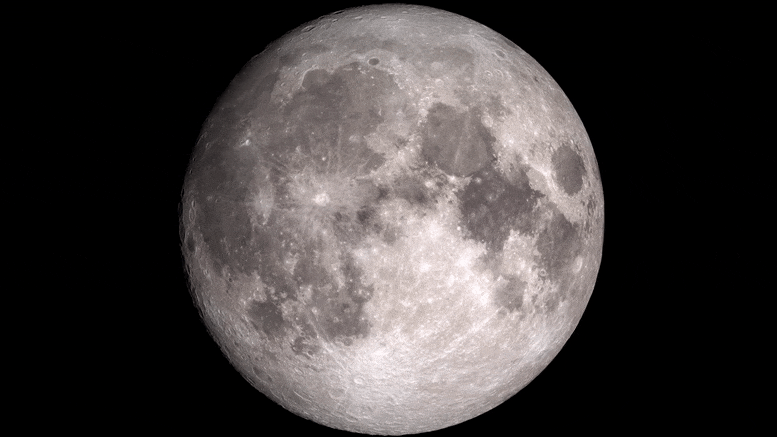
Moon phases.
The next full Moon will be early Saturday morning, February 27, 2021, appearing opposite the Sun in Earth-based longitude at 3:17 AM EST. This will be on Friday night from Alaska’s timezone westward to the International Date Line. The Moon will appear full for about three days around this time, from Thursday night through Sunday morning.
Here is a summary of celestial events between now and the full Moon after next (with angles and times based on the location of NASA Headquarters in Washington, DC):
As winter ends and spring begins in the northern hemisphere, the daily periods of sunlight continue to lengthen, changing at their fastest around the vernal or spring equinox. On Saturday, February 27, 2021 (the day of the full Moon), morning twilight will begin at 5:45 AM EST, sunrise will be at 6:43 AM, solar noon will be at 12:20:41 PM when the Sun will reach its maximum altitude of 43.06 degrees, sunset will be at 5:59 PM, and evening twilight will end at 6:57 PM. On the day before the start of Daylight Savings Time, Saturday, March 13, 2021, morning twilight will begin at 5:25 AM EST, sunrise will be at 6:22 AM, solar noon will be at 12:17:23 PM when the Sun will reach its maximum altitude of 48.49 degrees, sunset will be at 6:13 PM, and evening twilight will end at 7:11 PM. On the first day of Daylight Savings Time, Sunday, March 14, 2021, morning twilight will begin at 6:23 AM EDT, sunrise will be at 7:21 AM, solar noon will be at 1:17:07 PM when the Sun will reach its maximum altitude of 48.88 degrees, sunset will be at 7:14 PM, and evening twilight will end at 8:12 PM. On the day of the spring or vernal equinox, Saturday, March 20, 2021, morning twilight will begin at 6:14 AM EDT, sunrise will be at 7:11 AM, solar noon will be at 1:15:23 PM when the Sun will reach its maximum altitude of 51.25 degrees (90 degrees minus the latitude of NASA HQ), sunset will be at 7:20 PM, and evening twilight will end at 8:18 PM. By Sunday, March 28, 2021 (the day of the full Moon after next), morning twilight will begin at 6:00 AM EDT, sunrise will be at 6:59 AM, solar noon will be at 1:12:58 PM when the Sun will reach its maximum altitude of 54.40 degrees, sunset will be at 7:28 PM, and evening twilight will end at 8:26 PM.
On the evening of Saturday, February 27, 2021, (the day of this full Moon), as evening twilight ends (at 6:57 PM EST), the only planet visible will be Mars, appearing about 62 degrees above the west-southwestern horizon. The bright star appearing closest to directly overhead will be Capella at 83 degrees above the northern horizon. The bright stars of the Orion–Cygnus Arm of our home galaxy, including the easy-to-recognize constellation of Orion, will appear spread from the south-southeast up towards Mars. The three stars of Orion’s Belt will appear to point to the lower left towards the bright star Sirius at 31 degrees above the south-southeastern horizon. Sirius is the brightest of the stars in our sky (other than the Sun).
As the lunar cycle progresses, the planet Mars and the background of stars will appear to shift towards the west (although it is actually the Earth that is moving around the Sun towards the east). Mars will appear to shift more slowly than the stars (since Mars is moving around the Sun in the same direction as Earth). In mid March Mars will appear near the bright star Aldebaran. On March 19, 2021 the waxing crescent Moon will join Mars and Aldebaran to form a triangle, and the next night, March 20, 2021, will be when Mars and Aldebaran will appear at their closest, about 7 degrees apart.
By the evening of Sunday, March 28, 2021, (the day of the full Moon after next), as evening twilight ends (at 8:26 PM EDT), Mars will appear about 51 degrees above the western horizon. The bright star appearing closest to directly overhead will be Pollux at 79 degrees above the southern horizon. The bright stars of the local arm of our home galaxy, including the constellation Orion, will appear spread from the south up towards Mars. Sirius, the brightest of the stars in our sky (other than the Sun), will appear 33 degrees above the horizon in the south-southwest.
On the morning of Saturday, February 27, 2021, (the day of this full Moon), as morning twilight begins (at 5:45 AM EST), the bright star appearing closest to overhead will be Vega, one of the three stars in the Summer Triangle, at about 61 degrees above the horizon in the east-northeast. A close second will be the bright star Arcturus, appearing 59 degrees above the horizon in the west-southwest. The planet Mercury will appear in the east-southeast about 2 degrees above the horizon, with the fainter planet Saturn appearing about 5 degrees to the right and about 4 degrees above the horizon. About 4 minutes later (at 5:49 AM), the planet Jupiter will rise to the lower left of Mercury, shining brighter than both Mercury and Saturn. To see these three planets you will need a very clear view of the horizon in the east-southeast (something that can be difficult to find in our cluttered urban environments).
As the lunar cycle progresses, the background of stars and planets will appear to shift towards the west each morning, with the exception of Mercury, which will appear to shift towards the east and the horizon. March 1, 2021 will be the first morning that the bright planet Jupiter will appear above the horizon at the time morning twilight begins, appearing brighter than both Mercury and Saturn low in the east-southeast. On March 5, 2021, the planets Jupiter and Mercury will appear closest to each other at the time morning twilight begins, about 1.5 degrees above the horizon in the east-southeast. March 11, 2021, will be the last morning Mercury will appear above the horizon at the time morning twilight begins, although it should be visible in the glow of dawn until about 30 minutes before sunrise.
By the morning of Sunday, March 28, 2021, (the day of the full Moon after next), as morning twilight begins (at 6 AM EDT), the bright planet Jupiter and the fainter planet Saturn will appear with Jupiter about 9 degrees above the east-southeastern horizon and Saturn to the upper right at 14 degrees above the southeastern horizon. The bright star appearing closest to overhead will be Vega, one of the three stars in the Summer Triangle, at about 74 degrees above the eastern horizon. The planet Mercury will be lost in the glow of dawn, rising about 32 minutes before sunrise.
Here is a more detailed, day-by-day listing of celestial events between now and the full Moon after next (again based on the location of NASA Headquarters in Washington, DC):
Friday evening into early Saturday morning, February 19 to 20, 2021, the bright star Aldebaran will appear near the half-lit Moon. Aldebaran will appear about 8 degrees to the left of the Moon as evening twilight ends (at 6:49 PM EST), and will shift a degree or so closer by the time the Moon sets Saturday morning (at 1:39 AM).
By Saturday evening, February 20, 2021, the waxing gibbous Moon will have shifted to about 8 degrees to the upper left of Aldebaran, and the pair will continue to separate after that.
Even though they are not usually visible, I include in these Moon missives information about Near Earth Objects (mostly asteroids) that may pass the Earth within 5 lunar distances, because I find it interesting that we have discovered so many. On Sunday morning, February 21, 2021, at 6:21 AM EST (2021-Feb-21 11:21 UTC), Near Earth Object (2021 DD1), between 8 and 17 meters (25 to 56 feet) across, will pass the Earth at 4.3 lunar distances, traveling at 9.45 kilometers per second (21,100 miles per hour).
Sometime between Sunday morning, February 21, and Wednesday morning, February 24, 2021, Mercury will begin appearing brighter than Saturn (my two sources of brightness predictions differ on the date).
Tuesday morning, February 23, 2021, will be when Mercury and Saturn will appear at their closest together, just 4 degrees apart, low on the east-southeastern horizon (only 2 degrees above the horizon at the time morning twilight begins). After this, Mercury and Saturn will appear to separate, with Saturn continuing higher each morning while Mercury will appear to slow down, then begin to shift back towards the horizon each morning.
Tuesday evening into Wednesday morning, February 23 to 24, 2021, the bright star Pollux, one of the twins in the constellation Gemini, will appear near the waxing gibbous Moon. Pollux will appear about 4 degrees to the upper left of the Moon as evening twilight ends (at 6:53 PM EST). The Moon will reach its highest in the sky for the night (at 9:40 PM) with Pollux appearing about 5 degrees above the Moon. The Moon will set Wednesday morning (at 5:19 AM) with Pollux about 6 degrees to the right of the Moon.
Friday morning, February 26, 2021, the bright star Regulus will appear to the left of the full Moon. The pair will appear more than 8 degrees apart around midnight, but will shift closer together, appearing about 6 degrees apart as morning twilight begins (at 5:47 AM EST).
On Friday morning, February 26, 2021, the planet Mercury will appear at its highest above the horizon for this apparition at the time morning twilight begins, after which it will begin to shift back towards the horizon.
By Friday evening, February 26, 2021, the full Moon will appear to have shifted to the left of the bright star Regulus. As evening twilight ends (at 6:56 PM EST), Regulus will appear about 7 degrees to the upper right of the full Moon, and the pair will appear to separate as the evening progresses.
As mentioned above, the next full Moon will be early Saturday morning, February 27, 2021, at 3:17 AM EST. The Moon will appear full for about three days around this time, from Thursday evening, February 25, through Sunday morning, February 28, 2021.
On Saturday evening, February 27, 2021, at around 8 PM EST (2021-Feb-28 01:14 UTC with 2 hours, 58 minutes uncertainty), Near Earth Object (2021 DE), between 37 and 82 meters (120 to 269 feet) across, will pass the Earth at between 4.2 and 4.3 lunar distances (nominally 4.2), traveling at 25.71 kilometers per second (57,500 miles per hour).
Monday morning, March 1, 2020, will be the first morning when the bright planet Jupiter will be above the horizon as morning twilight begins (at 5:42 AM EST). Jupiter will appear in the east-southeast to the lower left of Mercury, with Saturn to the upper right.
Monday night into Tuesday morning, March 1 to 2, 2021, the bright star Spica will appear near the waning gibbous Moon. Spica will appear to the lower right of the Moon as it rises in the east-southeast (at 9:28 PM EST), Spica will appear below the Moon as the Moon reaches its highest in the sky for the night on Tuesday morning (at 2:55 AM), and morning twilight will begin around 5:41 AM.
Sometime on Monday night to Tuesday morning, March 1 to 2, 2021 (2021-Mar-02 00:01 UTC with 16 hours, 12 minutes uncertainty), Near Earth Object (2011 EH17), between 32 and 71 meters (105 to 234 feet) across, will pass the Earth at between 2.9 and 30.2 lunar distances (nominally 9.5), traveling at 16.83 kilometers per second (37,600 miles per hour).
Just after midnight on Tuesday morning, March 2, 2021, at 12:19 AM EST, the Moon will be at perigee, its closest to the Earth for this orbit.
On Tuesday evening, March 2, 2021, at 8:09 PM EST (2021-Mar-03 01:09 UTC), Near Earth Object (2016 DV1), between 29 and 65 meters (96 to 214 feet) across, will pass the Earth at 2.1 lunar distances, traveling at 18.27 kilometers per second (40,900 miles per hour).
Sometime around Wednesday morning, March 3, 2021 (2021-Mar-03 09:34 UTC with 11 hours, 24 minutes uncertainty), Near Earth Object (2021 DE1), between 8 and 19 meters (28 to 62 feet) across, will pass the Earth at between 4.1 and 4.5 lunar distances (nominally 4.3), traveling at 3.01 kilometers per second (6,700 miles per hour).
On Wednesday evening, March 3, 2021, the planet Mars will appear about 3 degrees from the star cluster known as the Pleiades or the Seven Sisters.
Tuesday morning, March 5, 2021, the bright star Antares will appear about 8 degrees below the waning gibbous Moon. Antares will rise after the Moon in the southeast (at 1:17 AM EST) and will appear about 6 degrees to the lower left of the Moon as morning twilight begins and the Moon reaches its highest in the sky (at 5:37 AM).
Also on Tuesday morning, March 5, 2021, the planets Jupiter and Mercury will appear at their closest to each other at the time morning twilight begins, about 1.5 degrees above the horizon in the east-southeast.
Friday evening, March 5, 2021, the waning Moon will appear half-full as it reaches its last quarter at 8:30 PM EST. For the Americas the half-moon will not rise until early Saturday morning (at 1:44 AM for the DC area).
Saturday morning, March 6, 2021, will be when the planet Mercury reaches its greatest angular separation from the Sun as seen from the Earth for this apparition (called greatest elongation), appearing half-lit through a large enough telescope. Because the angle of the line between the Sun and Mercury and the horizon changes with the seasons, the date when Mercury and the Sun appear farthest apart as seen from the Earth is not the same as when Mercury appears highest above the horizon in the east-southeast as morning twilight begins, which occurred on the morning of February 26, 2021.
Tuesday morning, March 9, 2021, the waning crescent Moon and the planets Saturn, Jupiter, and Mercury, will appear near the horizon from the southeast to the east-southeast. As morning twilight begins the Moon will appear on the right in the southeast at about 7 degrees above the horizon, with Saturn about 8 degrees to the left of the Moon in the east-southeast at about the same elevation above the horizon. The bright planet Jupiter will appear farther to the lower left at about 3 degrees above the horizon and Mercury will appear to the lower left of Jupiter at only 1 degree above the horizon.
By Wednesday morning, March 10, 2021, the waning crescent Moon will appear to have shifted to below and about halfway between Jupiter and Saturn in the east-southeast. As morning twilight begins, Saturn will appear on the right at about 8 degrees above the horizon, the Moon will appear to the lower left of Saturn only about a degree above the horizon, Jupiter will appear to the upper left of the Moon at 3 degrees above the horizon, and Mercury will appear farthest to the left at less than a degree above the horizon.
On Wednesday morning, March 10, 2021, at about 6:45 AM EST (2021-Mar-10 11:45 UTC with 36 minutes uncertainty), Near Earth Object (2021 CF6), between 46 and 103 meters (152 to 339 feet) across, will pass the Earth at between 4.1 and 4.2 lunar distances (nominally 4.2), traveling at 8.36 kilometers per second (18,700 miles per hour).
Thursday morning, March 11, 2021, will be the last morning Mercury will appear above the east-southeastern horizon at the time morning twilight begins, although Mercury should continue to be visible after it rises until about 30 minutes before sunrise.
Saturday morning, March 13, 2021, at 5:21 AM EST, will be the new Moon, when the Moon passes between the Earth and the Sun and will not be visible from the Earth.
The day of or the day after the New Moon marks the start of the new month for most lunisolar calendars. The second month of the Chinese year of the Ox starts on Saturday, March 13, 2021 (at midnight in China’s time zone, which is 13 hours ahead of EST). Sundown on Saturday, March 13, 2021, marks the start of Nisan in the Hebrew calendar. In the Islamic calendar the months traditionally start with the first sighting of the waxing crescent Moon. Many Muslim communities now follow the Umm al-Qura Calendar of Saudi Arabia, which uses astronomical calculations to start months in a more predictable way. Using this calendar the eighth month of the year, Sha’ban will begin at sunset on Saturday, March 13, 2021. Since Sha’ban is the month before Ramadan, it is during Sha’ban that Muslims finalize when to start fasting for Ramadan.
Sunday, March 14, 2021 is the first day of Daylight Savings Time. Don’t forget to reset your clocks and “Spring Forward.”
The waxing crescent Moon visible for a few nights beginning Sunday, March 14, 2021 (for the Washington, DC area and similar latitudes, at least) is called a “Wet Moon” or a “Cheshire Moon.” This is when the thin, waxing crescent Moon appears most like an upward-facing bowl or a smile in the evening sky. According to Wikipedia, the term “Wet Moon” originates from Hawaiian mythology when the Moon appears like a bowl that could fill up with water. The time of year when this occurs as viewed from the latitudes of the Hawaiian islands roughly corresponds with Kaelo the Water Bearer in Hawaiian astrology. As the year passes into summer, the crescent shape tilts each lunar cycle, pouring out the water and causing the summer rains. The term “Cheshire moon” is a reference to the smile of the Cheshire Cat in Lewis Carroll’s Alice’s Adventures in Wonderland.
Thursday, March 18, 2021, at 1:03 AM EDT, the Moon will be at apogee, its farthest from the Earth for this orbit.
On Friday night, March 19, 2021, the waxing crescent Moon, the planet Mars, and the bright star Aldebaran will form a triangle in the evening sky. Mars will appear about 3 degrees to the lower right of the Moon with Aldebaran appearing about 6 degrees to the lower left of the Moon. Aldebaran will set first in the west-northwest early Saturday morning (at 12:51 AM).
Saturday morning, March 20, 2021, at 5:37 AM EDT, will be the spring or vernal equinox, the astronomical end of winter and start of spring. From on the equator in eastern Kenya the Sun will appear to pass directly overhead, moving from the Southern Hemisphere to the Northern Hemisphere.
Saturday evening, March 20, 2021, will be when the planet Mars and the bright star Aldebaran will appear closest to each other, slightly under 7 degrees apart.
On Sunday morning, March 21, 2021, the Moon will appear half-full as it reaches its first quarter at 10:40 AM EDT.
On Monday evening into Tuesday morning, March 22 to 23, 2021, the bright star Pollux, the brighter of the twin stars in the constellation Gemini, will appear above the waxing gibbous Moon. Pollux will appear about 7 degrees to the upper left of the Moon as evening twilight ends (at 8:20 PM EDT), close to when the Moon will be highest in the sky for the night. Pollux will appear about 5 degrees to the upper right of the Moon by the time the Moon sets in the west-northwest on Tuesday morning (at 4:10 AM).
On Thursday evening into Friday morning, March 25 to 26, 2021, the bright star Regulus will appear about 5 degrees below the waxing gibbous Moon. Regulus will appear to the lower right of the Moon as evening twilight ends (at 8:23 PM EDT). By the time the Moon reaches its highest in the sky for the night (at 11:08 PM) Regulus will appear nearly below the Moon, and Regulus will set first in the west-northwest on Friday morning at 5:43 AM.
On Friday morning, March 26, 2021, the planet Venus will be passing on the far side of the Sun as seen from the Earth, called superior conjunction. Because Venus orbits inside of the orbit of Earth, Venus will be shifting from the morning sky to the evening sky. Venus will begin emerging from the glow of dusk on the western horizon after about April 23, 2021.
The full Moon after next will be Sunday afternoon, March 28, 2021, at 2:48 PM EDT. The Moon will appear full for about 3 days around this time, from early Saturday morning into early Tuesday morning.









… I will be watching the fool moon this time
hope you won’t be shading a tears,
because they would need to dry on their own…
Hoping for some good stuff!!